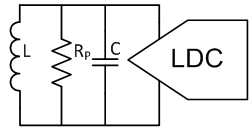SNOA930C March 2015 – May 2021 LDC0851 , LDC1001 , LDC1001-Q1 , LDC1041 , LDC1051 , LDC1101 , LDC1312 , LDC1312-Q1 , LDC1314 , LDC1314-Q1 , LDC1612 , LDC1612-Q1 , LDC1614 , LDC1614-Q1 , LDC2112 , LDC2114 , LDC3114 , LDC3114-Q1
2 Inductor Characteristics
To better understand how to obtain the optimum capabilities of a sensor, the sensor must be deconstructed into the inductor and the capacitor components. There are several inductor characteristics to consider, and while it may seem that there is an infinite range of possibilities for a given sensor, with use of the guidelines provided here, users can quickly converge on a suitable sensor design.
A parallel R-L-C electrical model of the sensor is shown in Figure 2-1.
 Figure 2-1 RLC Model
Figure 2-1 RLC ModelFirst, this app note needs to review the basic characteristics which determine the sensor capabilities.